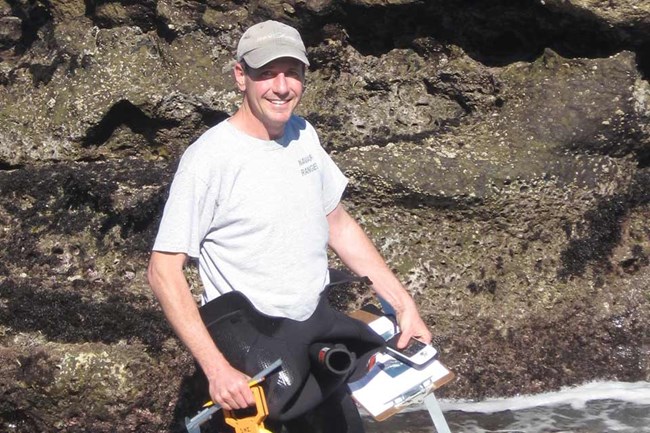
Chapter 3
John Ugoretz, US Navy biologist on San Nicolas Island, discusses how the island’s kelp forests provide an ideal habitat for sea otters and many other aquatic animals.
Kelp forests are found around the world. They are formed by a variety of marine algae. In Southern California, kelp forests occur in most nearshore rocky habitats. They are mostly made up of brown algae, commonly known as giant kelp. Giant kelp can grow as much as two feet per day in water depths from about five to 70 feet depending on the ocean depth and clarity of the water.
Because of its remote location, San Nicolas Island has clearer water than along the mainland coast, and much of the ocean around the island is the ideal depth for kelp growth. San Nicolas is home to one of the largest kelp forests of all the Channel Islands.
Kelp forests create a vertical habitat and canopy cover, similar to forests on the mainland, and provide shelter for a wide variety of fish. Common San Nicolas Island kelp forest fishes include California sheephead, lingcod, Garibaldi, kelp bass, señorita, a variety of surf perch, and other types of rockfish.
The kelp forest is also home to a variety of marine invertebrates including spiny lobster, crabs, sea urchins, abalone and many others. San Nicolas Island has greater populations of many of these fish and invertebrates than most other locations in Southern California.
Sea otters feed, sleep, and spend the majority of their lives in or near kelp forest habitats. They use the kelp canopy as shelter and will even wrap themselves in kelp while resting on the surface. Otters feed on many of the invertebrates found in the kelp, especially snails, urchins, and crabs. Sea urchins are so abundant around San Nicolas Island that they make up more than one quarter of the diet of island sea otters
Otters on San Nicolas have been found to be healthier than those near the California mainland coast. The abundant kelp and associated animals around San Nicolas provide an ideal location for sea otters to thrive.
-
Listen to chapter 3 entry
Learn about the sea otter habitat surrounding San Nicolas Island.
Chapter 13
John Ugoretz, US Navy biologist on San Nicolas Island, discusses the elephant seals’ physical characteristics and behavior during different times of the year.
Northern elephant seals live in Pacific Ocean coastal areas. Adult male elephant seals can weigh as much as 5,000 pounds and are 14–15 feet long. The elephant seal is named for the large overhanging nose of adult males, which looks similar to an elephant’s trunk. The females are smaller in comparison, weighing about 2,000 pounds and growing to about 10 feet in length. Elephant seal fur ranges from silvery grey in pups to dark brown in adults.
Elephant seals swim from San Nicolas northward into the Gulf of Alaska two times each year in what is called a “double migration.” Elephant seals make their first annual migration to breed and rear pups. The breeding season begins in December when the first males arrive on San Nicolas. The huge males engage in violent battles to establish dominance. The successful males do most of the breeding. Adult males are usually covered in scars on their necks and chests from these ritual mating battles.
In late December, the females begin to arrive and form “harems” on the beaches. About five days after arriving, females give birth to the pups that were conceived the previous year. The elephant seal pups, which are born weighing about 70 pounds, grow to 250–350 pounds in less than a month after feeding on their mothers’ rich milk. By March, most of the adult elephant seals have departed, leaving the weaned pups on the beach. The pups depart in mid to late April.
Elephant seals return to San Nicolas Island on their second migration to shed their fur. While most mammals shed their fur year round in small amounts, elephant seals “molt” or lose all of their fur and their outermost skin layer at once.
Molting elephant seals look shaggy and people often incorrectly assume the seals are sick. It takes about four weeks for the seals to molt completely and grow a new coat. Male and female elephant seals return to molt at different times of the year.
During these two migrations male elephant seals travel at least 13,000 miles and spend 250 days at sea each year. Females travel at least 11,000 miles and spend 300 days at sea.
For more information see:
http://www.afsc.noaa.gov/nmml/education/pinnipeds/nelephant.php
-
Listen to chapter 13 entry
Learn about elephant seals.
Last updated: November 3, 2017
